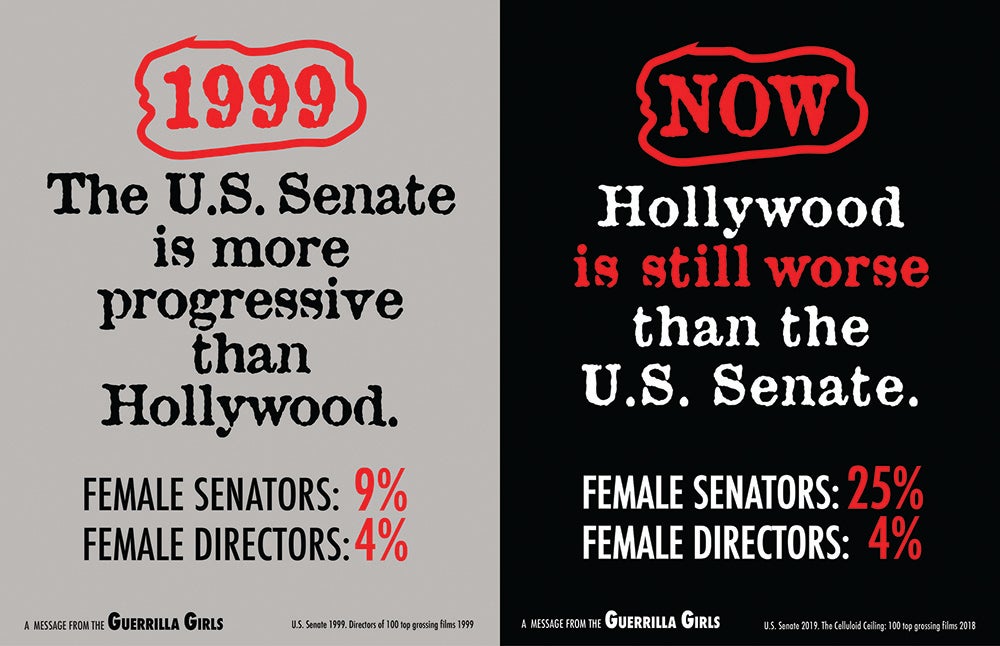The Guerrilla Girls have begun a campaign targeting the discriminatory practices of Hollywood. The collective released a new poster in February 2019, which includes statistics showing that the U.S. Senate is more diverse than Hollywood: Whereas Hollywood has 4 percent female directors, the Senate is currently 24 percent women. The poster also points out that while the Senate has at least gained some diversity in the last ten years, the proportion of female directors in Hollywood has stayed stagnant.

The group of activists, famous for wearing gorilla masks to hide their identities, formed in the 1980s to address inequality in the art world. The Guerrilla Girls deliver radical messages to cultural institutions using a technique they call “creative complaining.” In 1989, they created one of their most popular posters, which asks the question: “When racism & sexism are no longer fashionable, what will your art collection be worth?” Beneath that line is a list of over sixty female artists whose combined work could be purchased for the $17.7 million that had recently been spent on a single Jasper Johns painting.
As two Guerrilla Girls founders who go by the names of Frida Kahlo and Kathe Kollwitz wrote in 2010 in the Getty Research Journal,
We discovered we could purchase enough art by women artists, historical and contemporary, to fill an entire museum. What a great investment tip for art collectors! Too bad they hadn’t thought of it themselves. We’re happy to report this poster is no longer accurate… [but] women artists still lag way behind male artists at auction.
The Guerrilla Girls’ work is known for its humor. Kahlo and Kollwitz note that “In 1989, we went to the Metropolitan Museum of Art to conduct what we affectionately came to call the ‘wienie count.'” They tallied the female nudes vs. the male nudes, resulting in their famous poster that reads “Do Women Have to Be Naked to Get into the Met. Museum?”
As their work became more known, and they dug deeper into the inequities of museums and the art market, the Guerrilla Girls started to ask even more thorny questions. They write, “When we thought about that big question ‘Why have there been no great women artists?’ we realized there was another, even bigger, one to ask: ‘What happened to all the great women artists in history?'”
After years of challenging institutions, the Guerrilla Girls gained legitimacy by writing their own art history textbook, The Guerrilla Girls Bedside Companion to the History of Western Art. They have also infiltrated the most venerable spaces of the art world. In 2005, the Venice Biennale invited the collective to feature their work at the celebrated event. Kahlo and Kollwitz write, “First, we took on the Biennale itself, documenting 110 years of gender bias. But we also declared it the First Feminist Biennale. It was the first time the Biennale appointed women directors. And, surprise! The exhibitions they curated had the largest number of women artists ever!”
Weekly Digest
They also acknowledge the strangeness of being invited to take part in big-name art exhibits and museums. “Over the past several years we’ve been faced with a big dilemma. What do you do when the art institutions you’ve spent your entire life attacking suddenly embrace you?” The answer they arrived at was that you keep on doing what you’ve been doing, pointing out hypocrisy and inequities wherever they are found.
After more than thirty years of protesting and taking to the streets and museums to address the art world’s racism and sexism, the Guerrilla Girls are back to point out that not much has changed in Hollywood (and the U.S. Senate isn’t doing too hot either). And they’re far from finished. As their website says: “We could be anyone. We are everywhere. What’s next? More creative complaining!!”







